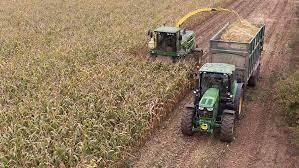Maize harvesting and threshing can simply be described as those methods used in harvesting and threshing maize. Some of the methods used in harvesting and threshing maize include the following;
1. Manual Harvesting
In village farming systems the crop is often harvested by hand, and cobs are stored in traditional structures. Quite often, the crop is left standing in the field long after the cobs have matured, so that the cobs may lose moisture and store more safely after harvest.
During this period the crop can suffer infestation by moulds and insects and be attacked by birds and rodents. To reduce such risks, an old practice (called “el doblado”) is sometimes applied in South and Central America.
This involves hand-bending the ears in the standing crop without removing them from the stalks. It helps mainly to prevent rainwater from entering the cobs, and also limits bird attacks; but, because of the high labour requirements involved, the practice is gradually falling into disuse.
Manual harvesting of maize does not require any specific tool; it simply involves removing the cob from the standing stalk. The work time averages 25 to 30 days per hectare.
Traditionally, maize cobs are commonly stored in their unhusked form. To improve their drying, it is often recommended to remove the husks from the cobs. Maize husking is usually a manual task carried out by groups of women.
Some machine manufacturers (e.g. Bourgoin in France) have developed stationary maize huskers, such as the “Tonga” unit.
2. Mechanized Harvesting
The first mechanized harvester to detach ears of maize from the standing stalks, the ‘corn snapper’, was built in North America in the middle of the 19th century. This was followed by the development of ‘corn pickers’, which incorporated a mechanism for removing the husks from the harvested ears.
The first animal-drawn maize pickers were replaced by tractor-drawn units (l or 2 rows) and then tractor-mounted units (1 row). Finally came the development of self-propelled units capable of harvesting from up to 4 rows.
Read Also : Methods of Crop Improvement and Production of Hybrid Seed
A specific feature in maize harvesters is the header which leaves the stalks standing as it removes the ears.
The rates of work can vary from 2 hours per hectare with a 3-row self- propelled harvester to 5 hours per hectare with a tractor-drawn or – mounted single row unit.
Generally speaking, harvest losses range from 3% to 5%, but they may be up to 10%-15% under adverse conditions.
Depending on the situation, a single-row harvester can be employed effectively on up to 20 hectares or more; but the use of a multi-row machine demands several tens of hectares to be economically effective.
Specially designed for harvesting maize as grain, the corn-sheller was initially a cornhusker in which the husking mechanism was replaced by a threshing one (usually of the axial type).

Corn-shellers are self- propelled machines of the 3 to 6-row type with capacities of 1 to 2 hours per hectare. The surface areas harvested during a 180-hour campaign range between 100ha (with a 3-row unit) and 200ha (with a 6-row one).
Another alternative consists of equipping a conventional combine with a number of headers corresponding to the machine horsepower. However, although widely used, such a method requires many adjustments to the threshing and cleaning mechanisms.
Read Also : Six (6) Factors Affecting Mechanized Harvesting Of Field Crops
Maize Threshing Methods
1. Shelling and Threshing
Traditional maize shelling is carried out as a manual operation: maize kernels are separated from the cob by pressing on the grains with the thumbs. According to the operator’s ability the work rate is about 10kg per hour.
Outputs up to 20kg per hour can be achieved with hand-held tools (wooden or slotted metal cylinders). To increase output, small disk shellers such as those marketed by many manufacturers can be recommended.
These are hand-driven or powered machines which commonly require 2 operators to obtain 150kg to 300kg per hour. Another threshing method, sometimes applied in tropical countries, involves putting cobs in bags and beating them with sticks; outputs achieved prove attractive but bags deteriorate rapidly.
2. Motorized Threshing
Nowadays, many small maize shellers, equipped with a rotating cylinder of the peg or bar type, are available on the market. Their output ranges between 500 and 2000kg per hour, and they may be driven from a tractor power take off or have their own engine; power requirements vary between 5 and 15hp according to the equipment involved.
For instance the French Bourgoin “Bamba” model seems well-suited to rural areas in developing countries because of its simple design, easy handling and versatility (maize, millet sorghum, etc.).
Read Also : Green Waste Complete Management Guide
